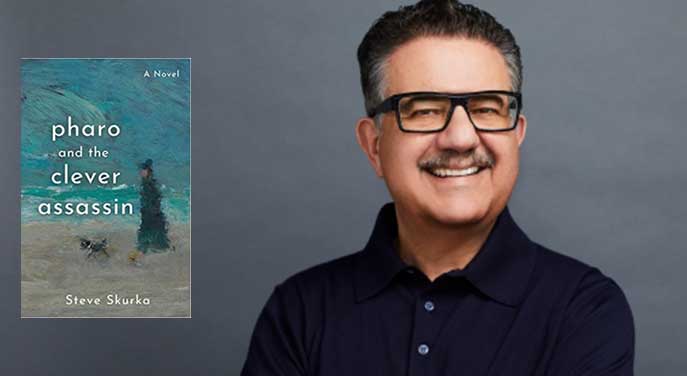 I’m regularly inundated with requests for writing, commentary and analysis on a wide variety of topics. This includes domestic and international politics, history, philosophy, military invasions and the ongoing global pandemic.
I’m regularly inundated with requests for writing, commentary and analysis on a wide variety of topics. This includes domestic and international politics, history, philosophy, military invasions and the ongoing global pandemic.
Don’t get me wrong. I thoroughly enjoy what I do. At the same time, taking small breaks from reality and delving into fantasy helps preserve my sanity.
For instance, I recently read Steve Skurka’s Pharo and the Clever Assassin.
A Toronto-based criminal lawyer and legal analyst on CTV, he’s the author of Tilted: The Trials of Conrad Black (2008) and co-author (with David Tanovich and David Paciocco) of Jury Selection in Criminal Trials: Skills, Science, and the Law (1997).
Skurka’s newest work is a change of pace: a first foray into the world of mystery and detective fiction. He’s written an intriguing fictional legal thriller intertwined with several real-life people, places and events.
The book focuses on the Sept. 6, 1901 assassination of U.S. President William McKinley. An anarchist, Leon Czolgosz, shot him twice in the abdomen inside the Pan-American Exposition’s Temple of Music in Buffalo, N.Y. McKinley survived for eight days but ultimately succumbed to gangrene. He was the third president to be assassinated, after Abraham Lincoln (1865) and James Garfield (1881).
Lawyer Burford Simmons has been assigned to defend Czolgosz. On the trial’s first day, he’s kidnapped under mysterious circumstances. This leads to an investigation to discover his whereabouts by Clarence Darrow (a real-life lawyer who worked on several high-profile cases, including the Scopes Monkey Trial) and Simmons’ wife, the novelist Pharo.
A parade of historical figures, including Sir Winston Churchill, U.S. Vice-President Theodore Roosevelt and the father of modern political Zionism, Theodor Herzl, either make appearances or are briefly referred to.
There’s a fascinating cast of supporting fictional characters, including Neeru Sharma (the first woman and Indigenous American to join the New York Bar Association) and Det. Eli Jacobs (a French Jew who fled his homeland during the 1894 Alfred Dreyfus affair to escape anti-Semitism). Even the eminent Sherlock Holmes and Dr. John Watson turn up.
The character of Pharo stands out most in this book. She’s a unique composite of innate intelligence and crafty outside-the-box thinking. Her diary entries and determination to find her missing husband help guide the story in several directions.
Pharo was apparently inspired by the author’s two daughters. Yet she also contains a few subtle dashes of Agatha Christie’s Miss Marple, mixed with the uncanny intelligence and humour of the real-life Maud West, known as “London’s Lady detective” in British circles.
Skurka is working on a sequel, Pharo and the Murder at Smoke Lake. If he can craft a similar tale of mystery and intrigue, it should be an equally enjoyable read.
I’ve also perused two exceptional books that studied the work of one great cartoonist.
Author Michael Tisserand recently recommended two impressive volumes published by Fantagraphics Books about Art Young. He was a talented U.S. political cartoonist in the late 19th century and early 20th century. A nominal Republican in his salad days, he gradually transformed into a socialist. (No one is perfect, of course.) His artistic talent and ability enabled him to produce hard-hitting social commentary for mainstream publications like The Saturday Evening Post and The New Yorker and left-wing publications like The Masses and The Nation.
Glenn Bray and Frank Young’s To Laugh That We May Not Weep: The Life and Times of Art Young (2017) is a superb examination of his life and career. Many cartoons, political and non-political, are reproduced with additional analysis. A few of them were part of his unpublished private collection.
Young’s anti-capitalist sentiments, and skeptical look at the nature of business and free markets, are apparent and way over the top at times. Nevertheless, there’s no denying that he had a brilliant artistic style and could easily capture the imagination of his audience.
It’s also worth going through Bray and Steven Heller’s Art Young’s Inferno (2020), a reproduction of Young’s 1934 re-imagination of Dante’s classic tale. In his Great Depression-inspired story, the self-styled capitalists and their followers have been condemned to “Satan’s Den,” or Hell. They mobilize to overthrow the underworld overlord and privatize the Inferno. In its place, a fiery capitalist atmosphere is established that, in Young’s view, is even worse than the original.
If you can look past the enormous left-wing political slant, it’s a fascinating tale by a socialist cartoonist hell-bent on changing the world.
What do I hear in the distance?
Reality is calling me again, it seems. But another trip to fantasy will surely be forthcoming.
Michael Taube, a Troy Media syndicated columnist and Washington Times contributor, was a speechwriter for former prime minister Stephen Harper. He holds a master’s degree in comparative politics from the London School of Economics. For interview requests, click here.
The opinions expressed by our columnists and contributors are theirs alone and do not inherently or expressly reflect the views of our publication.
© Troy Media
Troy Media is an editorial content provider to media outlets and its own hosted community news outlets across Canada.


